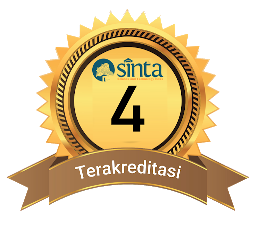Instrumen Berpikir Kritis untuk Mahasiswa Kimia
DOI:
10.29303/cep.v4i2.2264Published:
2021-08-14Issue:
Vol. 4 No. 2 (2021): Edisi Khusus Penelitian Pengembangan dalam rangka ulang tahun CEP yang ke 4Articles
Downloads
How to Cite
Abstract
Penelitian ini bertujuan untuk mengembangkan instrumen berpikir kritis untuk mahasiswa kimiaÃÂ sebagai prototipe awal dalam pengembangan instrumen yang valid dan reliabel. Penelitian ini dilakukan dalam beberapa tahap yaitu analisis literatur terkait berpikir kritis, analisis materi kimia, dan analisis karakteristik mahasiswa kimia; menyusun butir soal sesuai dengan hasil analisis materi kimia dan karakteristik mahasiswa; rancangan awal instrumen berpikir kritis; uji internal untuk mendapatkan tanggapan terkait rancangan awal instrumen; dan revisi rancangan awal sesuai hasil uji internal. Praktisi yang terlibat sebanyak tujuh orang dan sebanyak tiga orang ahli di bidang pendidikan kimia. Hasil analisis literatur menunjukkan bahwa instrumen pengukur berpikir kritis menggunakan soal atau laporan penyelidikan; indikator berpikir kritis yang selama ini diukur: analisis, evaluasi, inference, deduksi, induksi, membuat asumsi, ketelitian, perencanaan eksperimen, mengembangkan hipotesis, dan menguji hipotesis; bentuk soal adalah pilihan ganda dan soal essay. Indikator yang ada pada soal kimia di UNRAM adalah ketelitian, menganalisis, dan mengevaluasi; instrumen berpikir kritis belum dikembangkan terutama dalam menguji kemampuan mahasiswa dalam membuat asumsi, mengembangkan hipotesis dan menguji hipotesis. Rancangan awal soal adalah soal pilihan ganda namun dilengkapi dengan alasan sebanyak 20 butir soal dengan indikator ketelitian, membuat asumsi, mengembangkan hipotesis, menguji hipotesis, dan mengembangkan kesimpulan. Hasil penilaian ahli dan praktisi menunjukkan bahwa instrumen telah memenuhi indikator berpikir kritis dan layak dilakukan ujicoba dengan beberapa perbaikan.
References
Adair-Hauck, B., Glisan, E.W., Koda, K., Swender, E.B., & Sandrock, P. (2006). The integrated performance assessment (IPA): connecting assessment to instruction and learning. Foreign Language Annals, 39(3), 359 ââ¬â 382.
Al-Onizat, S. H. (2016). Measurement of multiple intelligences among sample of students with autism, and intellectual disability using teacher estimation and its relationship with the variables: The type and severity of disability, gender, age, type of center. International Journal of Education, 8(1), 107ââ¬â128.
Bailin, S., Case, R., Coombs, J.R., & Daniels, L.B. (1999). Conceptualizing critical thinking. Journal of Curriculum Studies, 31(3), 285-302.
Boud, D. (2009). Assesment 2020: seven propositions for assessment reform in higher education. Sydney: University of technology Sydney. www. Assessmentfutures. com.
Bowell, T., & Kemp, G. (2002). Critical thinking: a concise guide. London and New York: Routledge taylor & francis group.
Brookfield, S.D. (2012). Teaching for critical thinking: tools and techniques to help students question their assumptions. San Francisco: Jossey-Bass a Wiley Imprint.
Cottrell, S. (2005). Critical thinking skills: developing effective analysis and argument. New York: Palgrave Macmillan.
Danczak, S.M., Thompson, C.D., & Overtoon, T.L. (2020). Development and validation of an instrument to measure undergraduate chemistry studentsââ¬â¢ critical thinking skills. Chemistry Education Research and Practice, 21, 62-78.
Docktor, J., & Heller, K. (2009). Robust Assessment Instrument For Student Problem Solving. In The NARST 2009 Annual Meeting.
Ennis, R.H. (1985). A logical basis for measuring critical thinking skills. Educational Leadership, 43(2), 44-48.
Epstein, R.L., & Kernberger, C. (2006). Critical thinking. Kanada: Thomson Wadsworth.
Facione, P.A. (1990). Critical thinking: a statement of expert consensus for purposes of educational assessment and instruction. Millbrae CA: The California Academic Press.
Facione, P.A. (2000). The disposition toward critical thinking: its character, measurement and relation to critical thinking skill. Informal Logic, 20(1), 61-84.
Gregory, R.J. (2007). Psychological testing: history, principles, and applications. Boston: Pearson.
Halpern, D.F. (2003). Thought and knowledge: an introduction to critical thinking (4th ed). New Jersey: Lawrence Erlbaum Associates, Inc.
King, F.J., Goodson, L., & Rohani, F. (2011). Higher order thinking skills. Washington DC: Center of Advancement of Learning and Assessment www.cala.fsu.edu.
Lipman, M. (1988). Critical thinking: what can it be? Educational Leadership, 46(1), 38-43.
McPeck, J.E. (1990). Critical Thinking and Subject Specificity: A Reply to Ennis. Educational Researcher, 19(4), 10-12.
Mediartika, N., & Aznam, N. (2018). Pengembangan instrumen penilaian portofolio berbasis multiple intelligence untuk mengukur kemampuan berpikir kritis dan sikap ilmiah. Jurnal Inovasi Pendidikan IPA, 4(1), 52-63.
Paul, R.W. (1992). Critical thinking: what, why, and how? New Directions for Community Colleges, 77, 3-24. doi: 10.1002/cc.36819927703.
Rosen, Y., & Tager, M. (2013). Computer -based Assessment of Collaborative Problem Solving Skills: Human -to-Agent versus Human-to-Human Approach.
Saavedra, A.R., & Opfer, V.D. (2012). Teaching and learning 21st century skills: lessons from the learning sciences. London: RAND Corporation.
Stein, B.S., Hynes, A.F., & Unterstein, J. (2003). Assessing Critical Thinking Skills. Paper presented at. in SACS/COC Annual Meeting, Tennessee Technology University.
Sugiyono. (2015). Metode penelitian dan pengembangan (research and development/R&D): untuk bidang pendidikan, manajemen, sosial, teknik. Bandung: Alfabeta.
Sumarni, W., Supardi, K.I., & Widiarti, N. (2018). Development of assessment instruments to measure critical thinking skills. IOP Conf. Series: Material Science and Engineering, 349, 012066.
Author Biographies
Agus Abhi Purwoko, Universitas Mataram
Aliefman Hakim, Universitas Mataram
Saprizal Hadisaputra, Universitas Mataram
Yunita Arian Sani Anwar, Universitas Mataram
License
Authors who publish with Chemistry Education Practice agree to the following terms:
- Authors retain copyright and grant the journal right of first publication with the work simultaneously licensed under a Creative Commons Attribution License 4.0 International License (CC-BY-SA License). This license allows authors to use all articles, data sets, graphics, and appendices in data mining applications, search engines, web sites, blogs, and other platforms by providing an appropriate reference. The journal allows the author(s) to hold the copyright without restrictions and will retain publishing rights without restrictions.
- Authors are able to enter into separate, additional contractual arrangements for the non-exclusive distribution of the journal's published version of the work (e.g., post it to an institutional repository or publish it in a book), with an acknowledgement of its initial publication in Chemistry Education Practice.
- Authors are permitted and encouraged to post their work online (e.g., in institutional repositories or on their website) prior to and during the submission process, as it can lead to productive exchanges, as well as earlier and greater citation of published work (See The Effect of Open Access).






